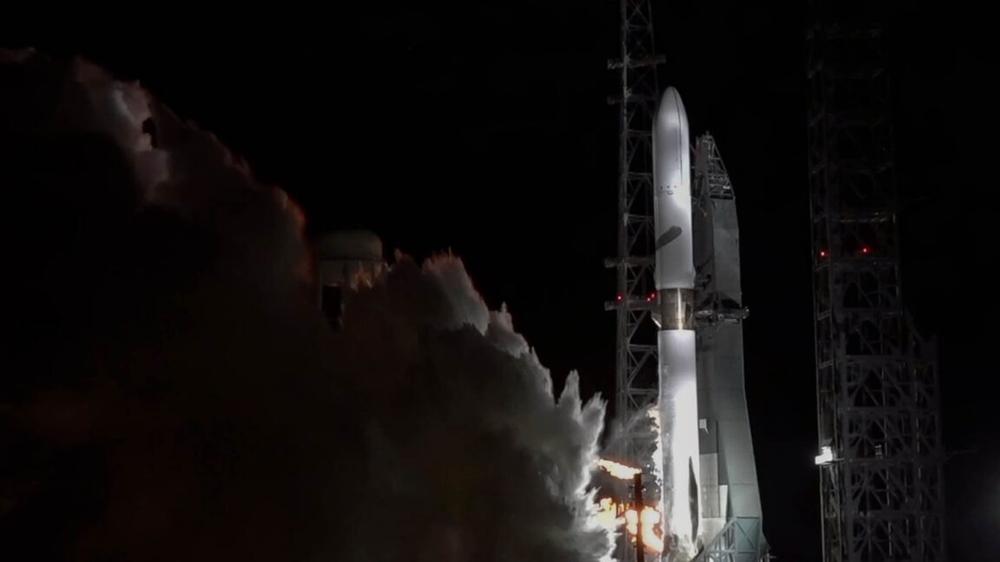The road to the second flight of Blue Origin’s heavy-lifting New Glenn rocket got a lot clearer Thursday night with a success test-firing of the launcher’s seven main engines on a launch pad at Cape Canaveral Space Force Station, Florida.
Standing on a seaside launch pad, the New Glenn rocket ignited its seven BE-4 main engines at 9:59 pm EDT Thursday (01:59 UTC Friday). The engines burned for 38 seconds while the rocket remained firmly on the ground, according to a social media post by Blue Origin.
The hold-down firing of the first stage engines was the final major test of the New Glenn rocket before launch day. Blue Origin previously test-fired the rocket’s second-stage engines. Officials have not announced a target launch date, but sources tell Ars the rocket could be ready for liftoff as soon as November 9.
“Love seeing New Glenn’s seven BE-4 engines come alive! Congratulations to Team Blue on today’s hotfire,” the company’s CEO, Dave Limp, posted on X.
Blue Origin, the space company owned by billionaire Jeff Bezos, said the engines operated at full power for 22 seconds, generating nearly 3.9 million pounds of thrust. Limp said engineers extended this test-firing and shut down some of the BE-4 engines to simulate the booster’s landing burn sequence, which Blue Origin hopes will culminate in a successful touchdown on a barge floating downrange in the Atlantic Ocean.
“This helps us understand fluid interactions between active and inactive engine feedlines during landing,” Limp wrote.
Blue Origin is counting on recovering the New Glenn first stage on the next flight after missing the landing on the rocket’s inaugural mission in January. Officials plan to reuse this booster on the third New Glenn launch early next year, slated to propel Blue Origin’s first unpiloted Blue Moon lander toward the Moon. If Blue Origin fails to land this rocket, it’s unlikely a new first stage booster will be ready to launch until sometime later in 2026.
A few more things to do
With the test-firing complete, Blue Origin’s ground crew will lower the more than 320-foot-tall (98-meter) rocket and roll it back to a nearby hangar. There, technicians will inspect the vehicle and swap its payload fairing for another clamshell containing two NASA-owned spacecraft set to begin their journey to Mars.
The twin spacecraft are part of NASA’s Escape and Plasma Acceleration and Dynamics Explorers (ESCAPADE) mission, a project aimed at studying the interaction between the solar wind and the magnetosphere of Mars. This interaction drives atmospheric escape, the mechanism by which scientists believe Mars transitioned from a warmer, wetter world into the rust-colored desert planet of today.
NASA is getting a good deal from Blue Origin for the launch of the ESCAPADE mission. The space agency is paying Bezos’ company $20 million for the launch, millions less than a dedicated launch on another rocket. But there’s a trade-off. NASA is accepting more risk on this mission because it’s just the second flight of the New Glenn rocket, which hasn’t yet been certified by NASA or the US Space Force for high-priority government launches.
Officials are fine with that because ESCAPADE is part of a new family of relatively low-cost Solar System missions. The mission’s total cost amounts to less than $80 million, an order of magnitude lower than all of NASA’s recent Mars missions. At this cost, NASA managers can live with a little more risk than they would for an $800 million mission.
Normally, Mars missions can launch from the Earth for only a few weeks about once every 26 months, when the planets are in the right position for a spacecraft to make a direct trip. ESCAPADE is launching outside of the normal Mars interplanetary window, so the twin probes will loiter relatively close to the Earth until next November, when they will fire their engines to set off for the red planet.
The ESCAPADE spacecraft, built by Rocket Lab, come nowhere close to filling the New Glenn rocket’s lift capacity. The fully fueled satellites combine to weigh a little more than a ton, about 15 percent of the total payload the rocket could deploy on ESCAPADE’s initial departure trajectory.
The two spacecraft will arrive at Mars in September 2027 and begin their science observations a few months later.

 Man left absolutely stunned after learning he’s named after Kyle from South Park
Man left absolutely stunned after learning he’s named after Kyle from South Park